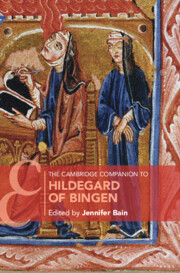Book contents
- The Cambridge Companion to Hildegard of Bingen
- The Cambridge Companion to Hildegard of Bingen
- Copyright page
- Dedication
- Contents
- Figures
- Tables
- Music Examples
- Contributors
- Acknowledgments
- Introduction
- Part I Life and Monastic Context
- Chapter 1 The Life of Hildegard of Bingen (1098–1179)
- Chapter 2 Living and Working in a Twelfth-Century Women’s Monastic Community
- Chapter 3 Literacy and Learning in the Lives of Women Religious in Medieval Germany
- Part II Writings and Reputation
- Part III Music, Manuscripts, Illuminations, and Scribes
- Select Bibliography
- Index
- Cambridge Companions To …
- References
Chapter 3 - Literacy and Learning in the Lives of Women Religious in Medieval Germany
from Part I - Life and Monastic Context
Published online by Cambridge University Press: 28 October 2021
- The Cambridge Companion to Hildegard of Bingen
- The Cambridge Companion to Hildegard of Bingen
- Copyright page
- Dedication
- Contents
- Figures
- Tables
- Music Examples
- Contributors
- Acknowledgments
- Introduction
- Part I Life and Monastic Context
- Chapter 1 The Life of Hildegard of Bingen (1098–1179)
- Chapter 2 Living and Working in a Twelfth-Century Women’s Monastic Community
- Chapter 3 Literacy and Learning in the Lives of Women Religious in Medieval Germany
- Part II Writings and Reputation
- Part III Music, Manuscripts, Illuminations, and Scribes
- Select Bibliography
- Index
- Cambridge Companions To …
- References
Summary
Although Hildegard of Bingen described herself multiple times in her writings as indocta (unlearned), medieval accounts and modern scholarship reveal discrepancies and conflicting information regarding this claim. What, then, was the extent of her education? Instead of answering this question directly by interrogating the intent, meaning, or reliability of her statements and those of her contemporaries, a broader picture of educational standards, resources, and contexts for the intellectual formation of women religious in medieval Germany is investigated. Invoking the full breadth of meaning of ‘women religious’ to include nuns, canonesses, consecrated widows, beguines, and anchorites unveils a wide-ranging scope of educational activity. Contemporary sources, including monastic and canonical rules, hagiographic literature of female vitae, and concrete evidence of libraries and scribal activity in female communities elucidate details of materials, learning conditions, pedagogy, and intellectual engagement and creativity. This chapter thus contextualizes the medieval German environment of female literacy and learning with which Hildegard would have been familiar.
Keywords
- Type
- Chapter
- Information
- The Cambridge Companion to Hildegard of Bingen , pp. 52 - 82Publisher: Cambridge University PressPrint publication year: 2021



